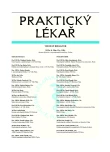-
Medical journals
- Career
Estimation of renal function changes on the basis of serum creatinine levels – potential and limitations
Authors: O. Schück 1; M. Horáčková 1; J. Smrčková 2; V. Teplan 3; M. Štollová 3; M. Pecková 1
Authors‘ workplace: Interní klinika FN Motol a 2. LF UK Praha Přednosta: prof. MUDr. Milan Kvapil, CSc. 1; Pracoviště laboratorních metod Přednosta: prof. MUDr. Antonín Jabor, CSc. 2; Klinika nefrologie Přednosta: doc. MUDr. Ondřej Viklický, CSc. Institut klinické a experimentální medicíny, Praha Ředitel: doc. MUDr. Jan Malý, CSc. 3
Published in: Prakt. Lék. 2009; 89(1): 42-45
Category: Diagnostis
Overview
Introduction:
In daily practice, changes of renal function are most commonly evaluated in the basis of serum creatinine (SCr) concentration. In this study, we tried to investigate if and how accurately SCr changes can be used to evaluate changes in renal creatinine clearance (CCr), and glomerular filtration rate (GFR) estimated on the basis of MDRD (Modification of Diet in Renal Disease) formula and accurately measured by renal inulin clearance (Cin).Methods:
In 32 patients suffering from chronic renal disease, with average SCr 202 (60–564) μmol/l, Cin was repeatedly measured and GFR was calculated on the basis of SCr and other parameters needed according to the MDRD formula. Relationships between a difference or SCr ratio found in the beginning (SCr)0 and the end of the study (SCr)t with appropriate values of Cin a MDRD were investigated. Regression analysis and the Bland-Altman analysis were used as a statistical tool.Results:
A highly significant linear relationship between values of (SCr)0/(SCr)t and (MDRD)t/(MDRD)0 was found (r=0,968; p<0,000). Evaluation of changes of GFR on the basis of (SCr)0/(SCr)t ratio yields equivalent information as evaluation of (MDRD)t/(MDRD)0 ratio. A significant linear dependence between values of (SCr)0/(SCr)t and (Cin)t/(Cin)0 were found, however the value of the correlation coefficient is substantially lower (r=0,474; p<0,000). Only greater changes of Cin can be evaluated on the basis of (SCr)0/(SCr)t.Conclusions:
A difference in creatinine serum concentrations (SKr)t - (SKr)0 allows us to evaluate deterioration or amelioration of renal function, however a quantitative change of renal function cannot be determined. The (SCr)t/(SCr)0 ratio enables a quantitative change of CCr, however such an evaluation is not easy, while the relationship between (SCr)t/(SCr)0 and (CCr)t/(CCr)0 is hyperbolic. Evaluation of the reciprocal value of (SCr)t/(SCr)0, i.e. (SCr)0/(SCr)t ratio is simpler, because the relationship between this value and both estimated and measured GFR is linear. This method enables the evaluation of renal function decrease as a percentage of initial value.Key words:
serum creatinine, glomerular filtration rate (GFR), evaluation of GFR changes.
Sources
1. Bland, J. M., Altman, D. G. Statistical methods for assesing agreement between two methods of clinical measurement. Lancet 1986, i, p. 307-310.
2. Cockcroft, D.V., Gault, M.H. Prediction of creatinine clearance from serum creatinine. Nephron 1976, 16, p. 31-41.
3. Levey, A.S., Bosch, J.P., Lewis, J.B. et al. A more accurate method to estimate glomerular filtration rate from serum creatinine: a new prediction equation. Ann. Intern. Med. 1999, 130, p. 461-470.
4. Peake, M. Whiting, M. Measurement of serum creatinine-current status and future goals. Clin. Biochem. Rev. 2006, 27, p. 173-184.
5. Perrone, R.D., Madias, N.E., Levey, A.S. Serum creatinine as an index of renal function: new insights into old cocepts. Clin. Chem. 1992, 38, p. 1933-1953.
6. Schück, O. Funkční vyšetřování ledvin. 2. vydání. Praha: Zdravotnické nakladatelství Avicenum 1979.
7. Schück, O., Horáčková, M. Relationship between serum creatinine increase or serum creatinine doubling and decrease of glomerular filtration rate estimated by predicting equations. Int. J. Clin. Pharmacol. Ther. 2007, 45, p. 40-41.
8. Shemesh, O, Golberty, H., Kriss, J. et al. Limitations of creatinine clearance as a filtration marker of glomerulopathic patients. Kidney, Int. 1985, 289, p. 830-838.
Labels
General practitioner for children and adolescents General practitioner for adults
Article was published inGeneral Practitioner

2009 Issue 1-
All articles in this issue
- The attitude towards long-term follow-up and coping with stress in patients diagnosed with melanoma
- Globalisation processes and harmonisation of the work of ethics committees in EU
- Chronic wound treatment in old age under supervision of a geriatrician
- Subacute thrombosis of two stents as a cause of acute myocardial infarction
- Estimation of renal function changes on the basis of serum creatinine levels – potential and limitations
- Identity of ethics committees, identity of ethicists
- Vaccination against cervical cancer and other sequelae of human papillomaviruses
- Current possibilities for the treatment of patients with epilepsy.
- Regulatory T cells and their prognostic value for head and neck oncology
- Nutritional care in premature babies after hospital discharge
- General Practitioner
- Journal archive
- Current issue
- Online only
- About the journal
Most read in this issue- Chronic wound treatment in old age under supervision of a geriatrician
- Nutritional care in premature babies after hospital discharge
- Current possibilities for the treatment of patients with epilepsy.
- Subacute thrombosis of two stents as a cause of acute myocardial infarction
Login#ADS_BOTTOM_SCRIPTS#Forgotten passwordEnter the email address that you registered with. We will send you instructions on how to set a new password.
- Career

